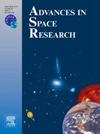Dust source dynamics in arid Iran: Examining the relationship between MODIS AOD and land surface characteristics in a dried catchment
IF 2.8
3区 地球科学
Q2 ASTRONOMY & ASTROPHYSICS
引用次数: 0
Abstract
Dust sources are expanding unprecedentedly across the arid parts of Iran. To quantify this trend in the Kaftar Catchment in SW Iran (5,600 km2), the MODIS AOD product “Optical_Depth_047″, accessible through Google Earth Engine was utilized, as one of the moderate-resolution (1 km) aerosol data sources spanning from 2002 to 2023. The layers were preprocessed and averaged to derive annual mean data (AM-AOD), and its accuracy was verified using reference dust data collected from 24 stations in 2022 (correlation coefficient = 0.565; p-value < 0.01). The Mann-Kendall trend test confirmed a statistically significant upward trend in AOD values. A positive Sen’s slope predominated for the majority of the AM-AOD pixels. The Generalized Additive Model (mean R2 = 0.753) successfully predicted AM-AOD values at each pixel for the year 2035. According to the Landsat 8-derived LULC map of the region (Kappa = 83.56), the wetland area is projected to experience the highest increase in AM-AOD in 2035, reaching 0.43 ± 0.06, while rangelands are expected to observe the lowest increment at 0.17 ± 0.07. Our study underscores the urgency of rehabilitating the Kaftar Wetland, promoting low-water crops, and improving ecosystem resilience in rangelands.
伊朗干旱地区尘源动态:MODIS AOD与干枯集水区地表特征关系的研究
在伊朗干旱地区,沙尘源正在前所未有地扩大。为了量化伊朗西南部Kaftar流域(5600平方公里)的这一趋势,利用MODIS AOD产品“Optical_Depth_047″”作为2002年至2023年的中分辨率(1公里)气溶胶数据源之一,该产品可通过谷歌地球引擎访问。对各层进行预处理和平均,得到年平均数据(AM-AOD),并利用2022年24个站点的参考扬尘数据(相关系数= 0.565;假定值& lt;0.01)。Mann-Kendall趋势检验证实AOD值有统计学上显著的上升趋势。对于大多数AM-AOD像素,正的Sen斜率占主导地位。广义加性模型(平均R2 = 0.753)成功预测2035年各像元AM-AOD值。根据Landsat 8衍生的区域LULC地图(Kappa = 83.56),预计2035年湿地区域AM-AOD增幅最大,达到0.43±0.06,而牧地区域AM-AOD增幅最小,为0.17±0.07。我们的研究强调了恢复卡夫塔湿地、推广低水量作物和提高牧场生态系统恢复能力的紧迫性。
本文章由计算机程序翻译,如有差异,请以英文原文为准。
求助全文
约1分钟内获得全文
求助全文
来源期刊

Advances in Space Research
地学天文-地球科学综合
CiteScore
5.20
自引率
11.50%
发文量
800
审稿时长
5.8 months
期刊介绍:
The COSPAR publication Advances in Space Research (ASR) is an open journal covering all areas of space research including: space studies of the Earth''s surface, meteorology, climate, the Earth-Moon system, planets and small bodies of the solar system, upper atmospheres, ionospheres and magnetospheres of the Earth and planets including reference atmospheres, space plasmas in the solar system, astrophysics from space, materials sciences in space, fundamental physics in space, space debris, space weather, Earth observations of space phenomena, etc.
NB: Please note that manuscripts related to life sciences as related to space are no more accepted for submission to Advances in Space Research. Such manuscripts should now be submitted to the new COSPAR Journal Life Sciences in Space Research (LSSR).
All submissions are reviewed by two scientists in the field. COSPAR is an interdisciplinary scientific organization concerned with the progress of space research on an international scale. Operating under the rules of ICSU, COSPAR ignores political considerations and considers all questions solely from the scientific viewpoint.
 求助内容:
求助内容: 应助结果提醒方式:
应助结果提醒方式:


